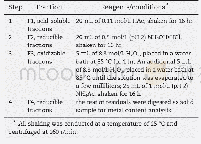《Table 1 Examples of the rules for extracting soil variables1)》
 提示:宽带有限、当前游客访问压缩模式
提示:宽带有限、当前游客访问压缩模式
本系列图表出处文件名:随高清版一同展现
《Automatic extraction and structuration of soil–environment relationship information from soil survey reports》
1) prefix,prefix of value;suffix,suffix of value;m,number;q,quantifier;wp,punctuation;“.”,any string;“*”,the frequency of 0 or more occurrences.
In this paper,the CRF++(http://taku910.github.io/crfpp)open source software was used to construct the CRFs model.As shown in Fig.4,the CRFs model is a supervised learning method,so it needs training before application.The commonly used training inputs for CRF++include training files and feature templates.An example of a training file is shown in Table 2:the first three columns are word,part-of-speech and K value.“Word”is the result of word segmentation and the carrier of other information,and part-of-speech is the basic grammatical attributes of words(Bird et al.2009).Both word and part-of-speech reflect the characteristics of linguistics.The K value is Boolean and stands for whether the current word is in the keyword dictionary,so it embodies the semantic information.The fourth column contains the tags represented in BIO format,which indicates the variable the word belongs to.For example,PM denotes parent material,and the tags B,I,E,and O denote the beginning,inside,ending and out of a variable value entity.B-PM means the current word is the beginning of the parent material value.
| 图表编号 | XD0047431500 严禁用于非法目的 |
|---|---|
| 绘制时间 | 2019.02.20 |
| 作者 | WANG De-sheng、LIU Jun-zhi、ZHU A-xing、WANG Shu、ZENG Can-ying、MA Tian-wu |
| 绘制单位 | Key Laboratory of Virtual Geographic Environment, Nanjing Normal University、State Key Laboratory Cultivation Base of Geographical Environment Evolution (Jiangsu Province)、Jiangsu Center for Collaborative Innovation in Geographic Information Resource Devel |
| 更多格式 | 高清、无水印(增值服务) |
查看“Table 1 Examples of the rules for extracting soil variables1)”的人还看了
-

- Table 1 Comparison on the chemical properties of soil samples cultivated with garden plants for over 3 years and less th
-

- Table 8 The performance of parent material value extraction for the descriptive text of soil types with the conditional
-

- Table 9 The performance of parent material value extraction for the descriptive text of soil profiles with the condition





